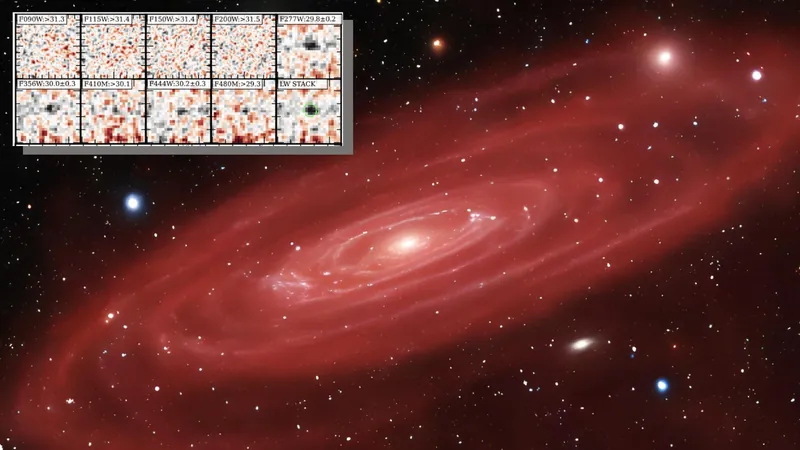
James Webb Space Telescope Pushes Boundaries, Spotting the Most Distant Galaxies Yet!
2024-11-25
Author: Michael
James Webb Space Telescope Discovers New Galaxies
The James Webb Space Telescope (JWST) has once again outdone itself, potentially spotting the earliest galaxies in the universe! This groundbreaking discovery could revolutionize our understanding of cosmic history.
The five newly identified galaxy candidates are located at such incredible distances that the furthest one is observed as it was a mere 200 million years after the Big Bang—meaning that light from these galaxies has traveled an astounding 13.6 billion years to reach us. Due to the universe's expansion, these galaxies are now projected to be a staggering 34 billion light-years away. However, it’s important to note that these findings are yet to be officially confirmed.
Previously, the most distant galaxy recognized by JWST was JADES-GS-z14-0, observed when the universe was around 280 million years old. The future names for these newly discovered galaxies will likely bear the prefix "GLIMPSE," honoring the expansive Galactic Legacy Infrared Midplane Survey Extraordinaire (GLIMPSE) project responsible for uncovering them. These might be some of the first galaxies to have ever existed, according to our current cosmological models.
Hakim Atek, one of the researchers involved in the discovery from the Paris Institute of Astrophysics, mentioned, "Estimating the exact age of these galaxies remains challenging, but we are certainly approaching the first generation since only about 150 million years are available for galaxy formation. There are limited pathways in which these galaxies could come to be."
Entering the Realm of High-Redshift Galaxies
The galaxies in question are classified as "high-redshift" or "high z" galaxies. This label comes from the phenomenon of redshift, where the expansion of the universe stretches the wavelengths of light emitted by these distant galaxies. As a result, light shifts toward the red end of the electromagnetic spectrum—the longer it travels, the more pronounced the redshift. For example, a redshift of z = 10 indicates that the light originated from approximately 13.2 billion years ago.
The JWST is now regularly finding galaxies with redshifts between z = 10 and z = 14. The previously recognized earliest galaxy has a redshift of z = 14.2. In contrast, the newly identified candidates boast redshifts ranging from z = 16 to z = 18, pushing the boundaries of our cosmic observations.
Team leader Vasily Kokorev from the University of Texas commented, “The discovery of these galaxies suggests that high-luminosity galaxies were more densely clustered in the early universe than originally anticipated. The density and brightness of these high-z galaxies challenge traditional models of galaxy formation.”
The Role of Gravitational Lensing
These incredible findings were made possible through the deepest observations in GLIMPSE history, aided by the Abell S1063 galaxy cluster located roughly 4 billion light-years away. This cluster acted as a gravitational lens, a concept predicted by Albert Einstein's theory of general relativity, which states that massive objects can warp the fabric of spacetime, bending the path of light traveling towards them.
The gravitational lensing effect allows JWST to capture these faint objects that would otherwise be virtually invisible. Kokorev pointed out that while the telescope can detect these brighter candidates, understanding their intrinsic characteristics will require more detailed spectral analysis.
Future Prospects and Challenges
As researchers dive deeper into the nature of these newly found galaxies, Atek noted, “These galaxies will evolve into the exceptionally bright galaxies we’ve previously observed when the universe was between 300 and 400 million years old.” However, the possibility of finding even earlier galaxies remains uncertain.
Kokorev cautioned that hunting for even fainter and more distant galaxies could demand significantly more observation time—potentially up to 450 hours—making it a daunting task, especially considering that the GLIMPSE project only utilized 150 hours.
Despite these challenges, the excitement surrounding these discoveries is palpable. Kokorev concluded, “This is just the beginning—there's so much more data to come from GLIMPSE and we’re eager to uncover further cosmic mysteries!”
Conclusion
Stay tuned as the JWST continues its mission to unravel the secrets of our universe, pushing the limits of human knowledge and cosmic exploration!









 Brasil (PT)
Brasil (PT)
 Canada (EN)
Canada (EN)
 Chile (ES)
Chile (ES)
 España (ES)
España (ES)
 France (FR)
France (FR)
 Hong Kong (EN)
Hong Kong (EN)
 Italia (IT)
Italia (IT)
 日本 (JA)
日本 (JA)
 Magyarország (HU)
Magyarország (HU)
 Norge (NO)
Norge (NO)
 Polska (PL)
Polska (PL)
 Schweiz (DE)
Schweiz (DE)
 Singapore (EN)
Singapore (EN)
 Sverige (SV)
Sverige (SV)
 Suomi (FI)
Suomi (FI)
 Türkiye (TR)
Türkiye (TR)